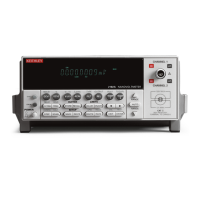Application
Sorting resistors
Limits can be used to sort resistors. Figure 8-2 shows a basic setup to test 10Ω resistors. The
Model 220 is used to source a constant 1mA through the resistor and the Model 2182 measures
the voltage drop.
Figure 8-2
Setup to test 10
Ω
resistors
For this application, the idea is to sort a batch of 10Ω resistors into three bins. Bin 1 is for
resistors that are within 1% of the nominal value. Bin 2 is for resistors that exceed 1% tolerance,
but are within 5%. Bin 3 is for resistors that exceed 5% tolerance.
Limit 1 will be used to test for the 1% tolerance and Limit 2 will be used to test for the 5%
tolerance. The Model 2182 does not directly measure resistance, so the tolerances have to be
converted to voltage values.
The voltage drop across a nominal 10Ω resistor is calculated as follows:
V
NOM
= 10Ω × 1mA
= 10mV
The voltage values for the 1% and 5% tolerances are calculated as follows:
V
1%
= 10mV × 1% V
5%
= 10mV × V
5%
= 10mV × 0.01 = 10mV × 0.05
= 0.1mV = 0.5mV
Finally, the high and low limits are calculated as follows:
HI Limit 1 = 10mV + V
1%
HI Limit 2 = 10mV + V
5%
= 10mV + 0.1mV = 10mV + 0.5mV
= 10.1mV = 10.5mV
LO Limit 1 = 10mV – V
1%
LO Limit 2 = 10mV – V
5%
= 10mV – 0.1mV = 10mV – 0.5mV
= 9.9mV = 9.5mV
The limits are illustrated in Figure 8-3.
Test Circuit
10Ω
HI
HI
LO
LO
DCV1CH 1
CH 2
2182
Model 220
Current Source
1mA
Limits 8-7

